 9-13-24
9-13-24
The Texas Supreme Court has granted review in a case from the Corpus Christi Court of Appeals raising the question of whether a mineral lessee owns subsurface caverns the lessee created in its salt mining operation.
Myers-Woodward, LLC v. Underground Services Markham, LLC, and United Brine Pipeline Company, LLC (No. 13-20-00172; No. 22-0878; granted August 30, 2024) arose from a dispute between a surface owner (Myers) and the mineral lessee on a 160-acre tract in Matagorda County. Myers leased the minerals (which included salt) to the company, reserving a 1/8 non-participating royalty interest. In 2013 the company sued Myers seeking declarations regarding the proper remittance methodology for royalty payments and that the company had a right to store hydrocarbons in subsurface cavern space created by the salt and brine mining operation. Myers countersued for negligence, gross negligence, trespass, civil theft, conversion, intentional misconduct, and breach of the duty of good faith and fair dealing. Myers also sought a declaration that the company owed royalties based on 1/8 of the proceeds of the sale of the salt, not at the wellhead, and that the surface owners maintained ownership of the underground salt caverns. The parties filed competing summary judgment motions. The trial court granted part of Myers’s motion, declaring that the company owed Myers a duty of utmost good faith and fair dealing and a duty to market Myers’s 1/8 royalty share of the salt produced. It further declared that the company could only use the subsurface caverns for the purposes specified in the deed, which include only the use of the surface and subsurface for mining, drilling, and operating for salt. Prior to a bench trial on the amount of royalties owed to Myers, the trial court held that as a matter of law the proper measure of royalties was 1/8 of the market value of the salt at the point of production (i.e., at the wellhead). After the bench trial, the trial court calculated that amount as $258,850.41 for the years 2015 through August, 2019. It entered a take-nothing judgment on Myers’s other claims. Both parties appealed.
In an opinion by Justice Tijerina, the court of appeals affirmed in part, reversed and rendered in part, and reversed and remanded in part. First, the court affirmed the trial court’s ruling that the royalty should be calculated according to the general rule, that is, at the wellhead, “meaning that post-production costs are deducted from the royalty payments.” The court found no language in the deed indicating an intent to deviate from the general rule by requiring the interest to be valued at the point of sale (a proceeds-based or “amount realized” royalty). Second, the court ruled that the company’s experts’ testimony as to the market value of the salt, which used comparable sales in the area, was legally sufficent and entitled to whatever weight the finder of fact placed upon it. At the same time, the court upheld the trial court’s exclusion of Myers’s valuation expert on the basis that the expert had no experience in valuating salt or any other minerals. Third, the court determined that the trial court’s judgment as to the amount of royalties owed to Myers had to be remanded because the judgment did not reflect the findings of fact (the judgment amount was based on higher prices for salt than the findings of fact reflected).
Perhaps the most important issue in the case, however, is who owns the salt dome created by the company’s mining operations. Here the court of appeals went with Myers, the surface owner, on the basis of the general rule that surface owners rights to the surface include “the geological structures beneath the surface” and “all non-mineral ‘molecules’ of the land, i.e., the mass that undergirds the surface,” and that “[t]he conveyance of mineral right ownership does not convey the entirety of the subsurface” (citations omitted). Applying the general rule, the court of appeals concluded that the company “merely owns the mineral estate, which includes ownership of the salt found in the subsurface materials…. [I]t does not ‘own’ any specific minerals while they are still in the ground,” much less the subsurface structures (citations omitted). Since the company didn’t own the caverns, it obviously couldn’t store hydrocarbons there.
SCOTX has scheduled oral arguments on October 29. We are highly interested in why SCOTX has decided to weigh in when Justice Tijerina’s opinion seems to rest entirely on well-settled authority. We do wonder whether the lessee’s argument that it made the salt dome makes any difference to the analysis. We shall see.











